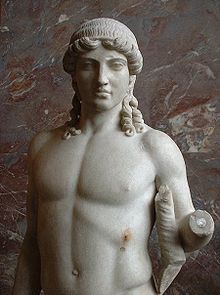
Apollo of Mantua
Encyclopedia

Apollo Citharoedus
An Apollo Citharoedus, or Apollo Citharede, designates a statue or other image of Apollo with cithara . Among the best-known realizations of this aspect of Apollo is the Apollo Citharoedus of the Vatican Museums, a 2nd century AD colossal marble statue of by an unknown Roman sculptor...
statue type, in which the god holds the cithara in his left arm. The type-piece, the first example discovered, is named for its location at Mantua; the type is represented by neo-Attic
Neo-Attic
Neo-Attic or Atticizing is a sculptural style, beginning in Hellenistic sculpture and vase-painting of the 2nd century BCE and climaxing in Roman art of the 2nd century CE, copying, adapting or closely following the style shown in reliefs and statues of the Classical and Archaic periods...
Imperial Roman copies of the late 1st or early 2nd century, modelled upon a supposed Greek bronze original made in the second quarter of the 5th century BCE, in a style similar to works of Polyclitus
Polykleitos
Polykleitos ; called the Elder, was a Greek sculptor in bronze of the fifth and the early 4th century BCE...
but more archaic. The Apollo held the cythara against his extended left arm, of which in the Louvre example (illustration) a fragment of one twisting scrolling horn upright remains against his biceps.
More than a dozen other replicas of the type have been found, the principal ones being those conserved in the national museums of Naples
Naples
Naples is a city in Southern Italy, situated on the country's west coast by the Gulf of Naples. Lying between two notable volcanic regions, Mount Vesuvius and the Phlegraean Fields, it is the capital of the region of Campania and of the province of Naples...
and of Mantua
Mantua
Mantua is a city and comune in Lombardy, Italy and capital of the province of the same name. Mantua's historic power and influence under the Gonzaga family, made it one of the main artistic, cultural and notably musical hubs of Northern Italy and the country as a whole...
.
The lost original would have been bronze. The name of the teacher of Phidias
Phidias
Phidias or the great Pheidias , was a Greek sculptor, painter and architect, who lived in the 5th century BC, and is commonly regarded as one of the greatest of all sculptors of Classical Greece: Phidias' Statue of Zeus at Olympia was one of the Seven Wonders of the Ancient World...
, Hegias of Athens
Hegias of Athens
Hegias or Hegesias of Athens was a famous sculptor of Athens, a member of the Late Archaic school of the generation before Pheidias. No surviving work can be securely identified as his, though Pliny mentions a Pyrrhus Supported by Pallas Athena....
is sometimes invoked, but there are no surviving examples of Hegias' work to judge from.
Examples include:
- The Naples Apollo of Mantua, a bronze found at PompeiiPompeiiThe city of Pompeii is a partially buried Roman town-city near modern Naples in the Italian region of Campania, in the territory of the comune of Pompei. Along with Herculaneum, Pompeii was destroyed and completely buried during a long catastrophic eruption of the volcano Mount Vesuvius spanning...
, in the Museo Archeologico Nazionale, Naples (inv. 5630).
- The Louvre Apollo of Mantua, formerly in the Bibliothèque MazarineBibliothèque MazarineThe Bibliothèque Mazarine is the oldest public library in France.- History :The Bibliothèque Mazarine was initially the personal library of cardinal Mazarin , who was a great bibliophile...
, entered the museum in 1871.
- The Fogg Art MuseumFogg Art MuseumThe Fogg Museum, opened to the public in 1896, is the oldest of Harvard University's art museums. The Fogg joins the Busch-Reisinger Museum and the Arthur M. Sackler Museum as part of the Harvard Art Museums....
Apollo of Mantua, a Roman bronze head of the Apollo of Mantua type, originally about one-third lifesize.
Further reading
- Congdon, Lenore O. Keene Congdon, 1963. "The Mantua Apollo of the Fogg Art Museum", American Journal of Archaeology 67.1 (January 1963), pp. 7–13.
- Louvre catalogue

